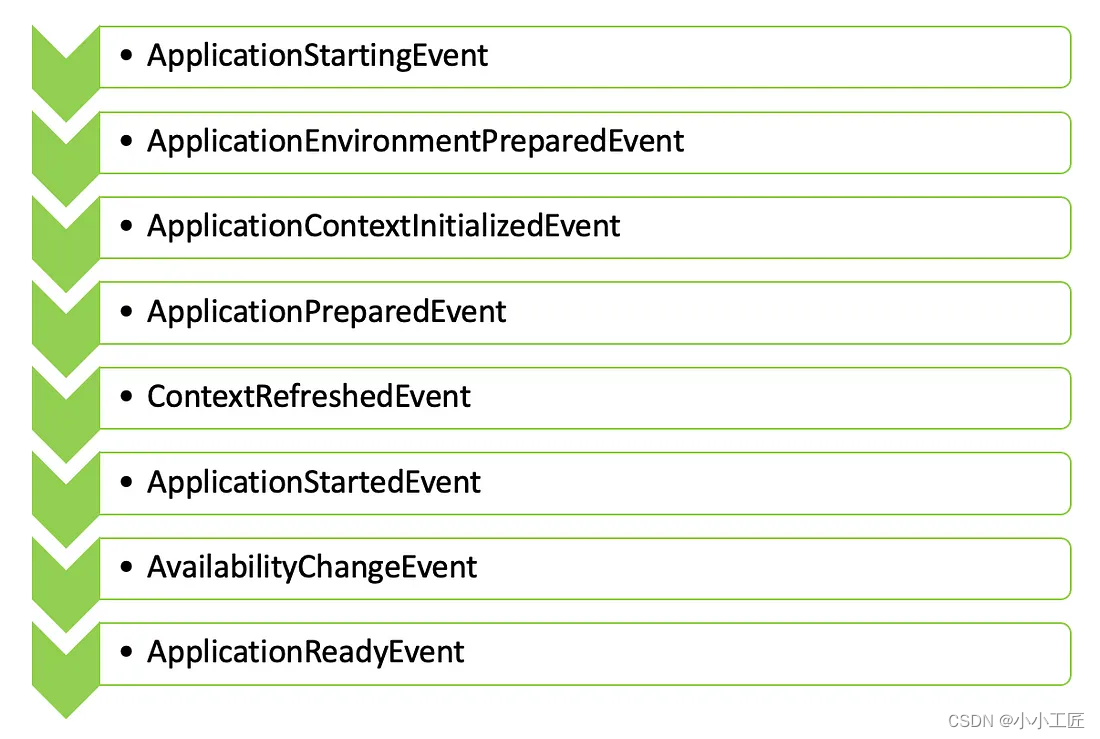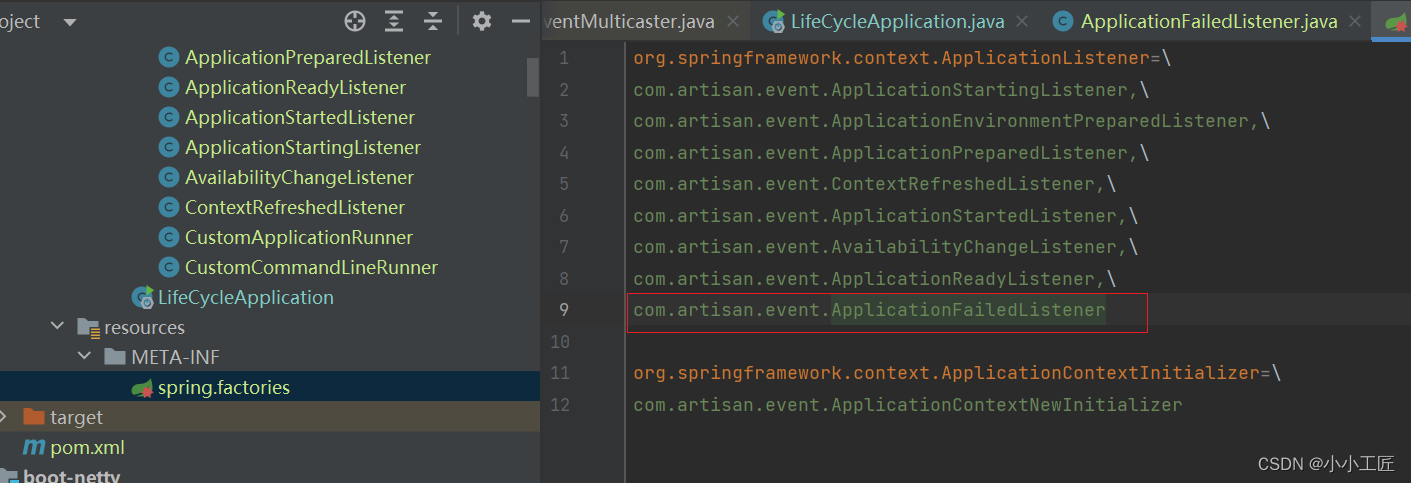文章目录
- Pre
- 概述
- Code
- 源码分析

Pre
Spring Boot - Application Events 的发布顺序_ApplicationEnvironmentPreparedEvent
概述
Spring Boot 的广播机制是基于观察者模式实现的,它允许在 Spring 应用程序中发布和监听事件。这种机制的主要目的是为了实现解耦,使得应用程序中的不同组件可以独立地改变和复用逻辑,而无需直接进行通信。
在 Spring Boot 中,事件发布和监听的机制是通过 ApplicationEvent、ApplicationListener 以及事件发布者(ApplicationEventPublisher)来实现的。其中,ApplicationEvent 是所有自定义事件的基础,自定义事件需要继承自它。
ApplicationListener 是监听特定事件并做出响应的接口,开发者可以通过实现该接口来定义自己的监听器。事件发布者(通常由 Spring 的 ApplicationContext 担任)负责发布事件。
在Spring框架中,ApplicationFailedEvent 是一个特殊的事件,它代表了应用程序在启动过程中遇到的失败情况。这个事件是在Spring的应用程序生命周期中,当应用程序启动失败时触发的。
ApplicationFailedEvent 事件通常包含了有关失败原因的信息,例如异常类型、异常消息、发生错误的类和方法、以及失败发生的时间等。这个事件是Spring事件机制的一部分,它允许开发者在应用程序中实现事件驱动的设计。
在Spring框架中,事件机制是基于观察者模式的实现。事件发布者和事件监听器通过事件进行通信。在Spring中,事件发布者通常是通过 ApplicationEventPublisher 接口来进行操作的,而事件监听器则通过实现 ApplicationListener 接口来定义。
当Spring应用程序启动时,它会经历多个阶段。如果在某个阶段发生了错误,比如在初始化数据源时出现了异常,Spring会发布 ApplicationFailedEvent 事件。事件监听器可以监听这个事件,并对事件进行处理,比如记录日志、发送警报或者进行补偿操作等。
在Spring Boot应用程序中,ApplicationFailedEvent 事件也可以被用来处理启动时的异常情况。Spring Boot提供了一种更简化的方式来监听这个事件,即使用 @EventListener 注解。这种方式可以让开发者更容易地编写事件监听器,而不需要实现复杂的接口。
例如,以下是一个简单的 @EventListener 注解的使用示例,用于监听 ApplicationFailedEvent 事件:
@Component
public class ApplicationFailedListener {@EventListenerpublic void onApplicationFailedEvent(ApplicationFailedEvent event) {Throwable throwable = event.getException();// 对异常进行处理,比如记录日志System.err.println("Application failed to start: " + throwable.getMessage());}
}
当应用程序启动失败时,这个监听器会被触发,并可以执行相应的错误处理逻辑。这样,开发者可以更好地管理应用程序的启动过程,并在遇到失败时进行适当的响应。
Code
package com.artisan.event;import org.springframework.boot.context.event.ApplicationFailedEvent;
import org.springframework.context.ApplicationListener;/*** @author 小工匠* @version 1.0* @mark: show me the code , change the world*/
public class ApplicationFailedListener implements ApplicationListener<ApplicationFailedEvent> {@Overridepublic void onApplicationEvent(ApplicationFailedEvent event) {System.out.println("--------------------> Handling ApplicationFailedEvent here!");Throwable throwable = event.getException();// 对异常进行处理,比如记录日志System.err.println("Application failed to start: " + throwable.getMessage());}
}如何使用呢?
方式一:
@SpringBootApplication
public class LifeCycleApplication {/*** 除了手工add , 在 META-INF下面 的 spring.factories 里增加* org.springframework.context.ApplicationListener=自定义的listener 也可以** @param args*/public static void main(String[] args) {SpringApplication springApplication = new SpringApplication(LifeCycleApplication.class);springApplication.addListeners(new ApplicationFailedListener());springApplication.run(args);}}方式二: 通过spring.factories 配置

org.springframework.context.ApplicationListener=\
com.artisan.event.ApplicationFailedListener
运行日志

源码分析
首先main方法启动入口
SpringApplication.run(LifeCycleApplication.class, args);
跟进去
public static ConfigurableApplicationContext run(Class<?> primarySource, String... args) {return run(new Class<?>[] { primarySource }, args);}
继续
public static ConfigurableApplicationContext run(Class<?>[] primarySources, String[] args) {return new SpringApplication(primarySources).run(args);}
这里首先关注 new SpringApplication(primarySources)
new SpringApplication(primarySources)
/*** Create a new {@link SpringApplication} instance. The application context will load* beans from the specified primary sources (see {@link SpringApplication class-level}* documentation for details. The instance can be customized before calling* {@link #run(String...)}.* @param resourceLoader the resource loader to use* @param primarySources the primary bean sources* @see #run(Class, String[])* @see #setSources(Set)*/@SuppressWarnings({ "unchecked", "rawtypes" })public SpringApplication(ResourceLoader resourceLoader, Class<?>... primarySources) {this.resourceLoader = resourceLoader;Assert.notNull(primarySources, "PrimarySources must not be null");this.primarySources = new LinkedHashSet<>(Arrays.asList(primarySources));this.webApplicationType = WebApplicationType.deduceFromClasspath();this.bootstrappers = new ArrayList<>(getSpringFactoriesInstances(Bootstrapper.class));setInitializers((Collection) getSpringFactoriesInstances(ApplicationContextInitializer.class));setListeners((Collection) getSpringFactoriesInstances(ApplicationListener.class));this.mainApplicationClass = deduceMainApplicationClass();}
聚焦 setListeners((Collection) getSpringFactoriesInstances(ApplicationListener.class));
run
继续run
// 开始启动Spring应用程序
public ConfigurableApplicationContext run(String... args) {StopWatch stopWatch = new StopWatch(); // 创建一个计时器stopWatch.start(); // 开始计时DefaultBootstrapContext bootstrapContext = createBootstrapContext(); // 创建引导上下文ConfigurableApplicationContext context = null; // Spring应用上下文,初始化为nullconfigureHeadlessProperty(); // 配置无头属性(如:是否在浏览器中运行)SpringApplicationRunListeners listeners = getRunListeners(args); // 获取运行监听器listeners.starting(bootstrapContext, this.mainApplicationClass); // 通知监听器启动过程开始try {ApplicationArguments applicationArguments = new DefaultApplicationArguments(args); // 创建应用参数ConfigurableEnvironment environment = prepareEnvironment(listeners, bootstrapContext, applicationArguments); // 预备环境configureIgnoreBeanInfo(environment); // 配置忽略BeanInfoBanner printedBanner = printBanner(environment); // 打印Bannercontext = createApplicationContext(); // 创建应用上下文context.setApplicationStartup(this.applicationStartup); // 设置应用启动状态prepareContext(bootstrapContext, context, environment, listeners, applicationArguments, printedBanner); // 准备上下文refreshContext(context); // 刷新上下文,执行Bean的生命周期afterRefresh(context, applicationArguments); // 刷新后的操作stopWatch.stop(); // 停止计时if (this.logStartupInfo) { // 如果需要记录启动信息new StartupInfoLogger(this.mainApplicationClass).logStarted(getApplicationLog(), stopWatch); // 记录启动信息}listeners.started(context); // 通知监听器启动完成callRunners(context, applicationArguments); // 调用Runner}catch (Throwable ex) {handleRunFailure(context, ex, listeners); // 处理运行失败throw new IllegalStateException(ex); // 抛出异常}try {listeners.running(context); // 通知监听器运行中}catch (Throwable ex) {handleRunFailure(context, ex, null); // 处理运行失败throw new IllegalStateException(ex); // 抛出异常}return context; // 返回应用上下文
}我们重点看
handleRunFailure(context, ex, listeners); // 处理运行失败
继续
private void handleRunFailure(ConfigurableApplicationContext context, Throwable exception,SpringApplicationRunListeners listeners) {try {try {handleExitCode(context, exception);if (listeners != null) {listeners.failed(context, exception);}}finally {reportFailure(getExceptionReporters(context), exception);if (context != null) {context.close();}}}catch (Exception ex) {logger.warn("Unable to close ApplicationContext", ex);}ReflectionUtils.rethrowRuntimeException(exception);}
继续 listeners.failed(context, exception);
void failed(ConfigurableApplicationContext context, Throwable exception) {doWithListeners("spring.boot.application.failed",(listener) -> callFailedListener(listener, context, exception), (step) -> {step.tag("exception", exception.getClass().toString());step.tag("message", exception.getMessage());});}继续 callFailedListener;
private void callFailedListener(SpringApplicationRunListener listener, ConfigurableApplicationContext context,Throwable exception) {try {listener.failed(context, exception);}catch (Throwable ex) {if (exception == null) {ReflectionUtils.rethrowRuntimeException(ex);}if (this.log.isDebugEnabled()) {this.log.error("Error handling failed", ex);}else {String message = ex.getMessage();message = (message != null) ? message : "no error message";this.log.warn("Error handling failed (" + message + ")");}}}
@Overridepublic void failed(ConfigurableApplicationContext context, Throwable exception) {ApplicationFailedEvent event = new ApplicationFailedEvent(this.application, this.args, context, exception);if (context != null && context.isActive()) {// Listeners have been registered to the application context so we should// use it at this point if we cancontext.publishEvent(event);}else {// An inactive context may not have a multicaster so we use our multicaster to// call all of the context's listeners insteadif (context instanceof AbstractApplicationContext) {for (ApplicationListener<?> listener : ((AbstractApplicationContext) context).getApplicationListeners()) {this.initialMulticaster.addApplicationListener(listener);}}this.initialMulticaster.setErrorHandler(new LoggingErrorHandler());this.initialMulticaster.multicastEvent(event);}}
context.publishEvent(event);
@Overridepublic void failed(ConfigurableApplicationContext context, Throwable exception) {ApplicationFailedEvent event = new ApplicationFailedEvent(this.application, this.args, context, exception);if (context != null && context.isActive()) {// Listeners have been registered to the application context so we should// use it at this point if we cancontext.publishEvent(event);}else {// An inactive context may not have a multicaster so we use our multicaster to// call all of the context's listeners insteadif (context instanceof AbstractApplicationContext) {for (ApplicationListener<?> listener : ((AbstractApplicationContext) context).getApplicationListeners()) {this.initialMulticaster.addApplicationListener(listener);}}this.initialMulticaster.setErrorHandler(new LoggingErrorHandler());this.initialMulticaster.multicastEvent(event);}}
继续this.initialMulticaster.multicastEvent(event);
@Overridepublic void multicastEvent(ApplicationEvent event) {multicastEvent(event, resolveDefaultEventType(event));}继续
@Override
public void multicastEvent(final ApplicationEvent event, @Nullable ResolvableType eventType) {// 如果eventType不为null,则直接使用它;否则,使用resolveDefaultEventType方法来解析事件的默认类型。ResolvableType type = (eventType != null ? eventType : resolveDefaultEventType(event));// 获取一个线程池执行器,它用于异步执行监听器调用。Executor executor = getTaskExecutor();// 获取所有对应该事件类型的监听器。for (ApplicationListener<?> listener : getApplicationListeners(event, type)) {// 如果执行器不为null,则使用它来异步执行监听器调用;// 否则,直接同步调用监听器。if (executor != null) {executor.execute(() -> invokeListener(listener, event));}else {invokeListener(listener, event);}}
}继续
/*** 调用一个事件监听器的方法。** @param listener 要调用的监听器* @param event 要处理的事件*/
private void doInvokeListener(ApplicationListener listener, ApplicationEvent event) {try {// 直接调用监听器的onApplicationEvent方法listener.onApplicationEvent(event);}catch (ClassCastException ex) {String msg = ex.getMessage();// 如果消息为null或者消息匹配事件类的预期类型,则忽略异常并记录debug日志if (msg == null || matchesClassCastMessage(msg, event.getClass())) {Log logger = LogFactory.getLog(getClass());if (logger.isTraceEnabled()) {logger.trace("Non-matching event type for listener: " + listener, ex);}}// 否则,抛出异常else {throw ex;}}
}继续 就会调到我们自己的业务逻辑了
@Overridepublic void onApplicationEvent(ApplicationFailedEvent event) {System.out.println("--------------------> Handling ApplicationFailedEvent here!");Throwable throwable = event.getException();// 对异常进行处理,比如记录日志System.err.println("Application failed to start: " + throwable.getMessage());}






 + 第 3 场 强者挑战赛 (1 ~ 5))

——静态验证)
:基于Q-learning算法的无人车配送路径规划(通过Python代码))







音频采集编码写入详细源码分析)


